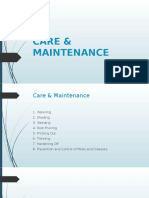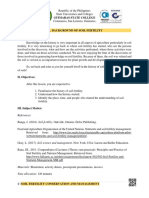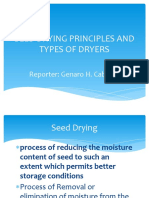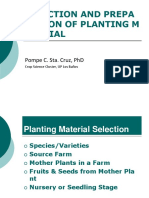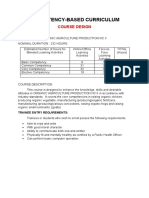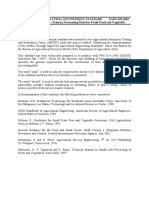Land Preparation
Land Preparation
Uploaded by
Diana DainaCopyright:
Available Formats
Land Preparation
Land Preparation
Uploaded by
Diana DainaOriginal Description:
Copyright
Available Formats
Share this document
Did you find this document useful?
Is this content inappropriate?
Copyright:
Available Formats
Land Preparation
Land Preparation
Uploaded by
Diana DainaCopyright:
Available Formats
Land Preparation
Introduction
Land preparation or Tillage practice is a very important practice to enhance good yield from
crops grown. It is one of the measures used to control crop diseases and pest invasion.
The purpose of land preparation is to provide the best soil conditions which will enhance the
successful establishment of the tissue culture plants. It is one of the measures used to control crop
diseases and pest invasion. Land preparation is also called as tillage practice; tillage practice is the
mechanical pulverization or manipulation of the soil to take about favorable conditions for the
growth of crops. Tillage practices include all operations used for the function of modifying the soil
characteristics. It costs about 30% of the total cost of cultivation.
Objective of Land Preparation
To develop potential tree growth, survival, and uniformity of a crop about to be established
(planted). Through proper land preparation, factors that limit tree growth are reduced. These factors
will be included; you should be aware of land preparation types for proper implementation.
Poor drainage
Frost
Weed competition
Heavy slash
Compacted or naturally dense soils
Land preparation improves site conditions in one or
more of the following ways:
Reducing weed competition for light and
nutrients
Improving soil, water, and air conditions
through and water cultivation
Loosening tight or compacted soils to allow
Reducing frost susceptibility during
mounding.
Tillage for Soil Conservation
Tillage is an important and the main tool for conservation of the land. As per definition, its
primary function is to provide a favorable soil environment for the plant growth, which is indirectly
related to soil conservation. The effect of tillage on soil erosion is the purpose of its several effects
on soil such as aggregation surface sealing infiltration and resistant to erosion, destruction of soil
structure either by excessive tillage or tillage operations at improper soil moisture condition tends to
raise the soil erodibility, causing significant soil loss. To achieve a better result for soil conservation
the following points must be considered for tillage operations.
1. Till no more than necessary
2. Till only when soil moisture is in the good limit and
3. Vary the depth of ploughing.
Tillage Depth:
A plowing depth in the 15-20 cm range is generally adequate, and there is seldom any
advantage in going deeper. In fact, shallower plowing is often suggested for low rainfall areas to
conserve moisture.
Different Land Preparation Techniques:
1. Conventional Tillage
2. Minimum Tillage
3. Zero Tillage
Conventional Tillage:
The sequence of operations traditionally or most generally used in a given geographic area
to produce a given crop. The operations used vary considerably for different crops and in different
regions.
Minimum Tillage:
Minimum tillage is the small manipulation of the soil. It is otherwise referred to as traditional
tillage process. It is not as sophisticated and technical as the conventional tillage. It involves the use
of the cutlass to slash weeds and vegetation regrowth on the farm, the less manipulation is done
with the hoe and rake.
Zero Tillage Practice:
Otherwise called no tillage is a simplified form of minimum tillage. It involves only opening a
narrow strip about 2 to 3cm wide or hole in the ground for seed or seedling placement. Zero tillage
is no pre-planting seedbed preparation. Weeds are taken care of with the use of herbicides and
cutlass without disturbing the land. The crop is then planted directly without tilling or ploughing the
soil, this process is highly effective under sloppy lands where soil and water erosion are heavy.
Methods Involving No-Tillage or Seedbed Shaping:
Slash, burn and plant: this process is most suitable for sandy soils which are naturally loose or for
other soils that are maintained in good tilth (a loose, crumbly situation) by a lengthy vegetative
fallow which produces soil humus. It may be the feasible method for rocky soils or those with
pronounced slopes where tillage would accelerate erosion.
Slash, mulch, and plant: this process is suited to the same conditions. The vegetation is slashed down
or killed with an herbicide and then left on the surface to form mulch (a protective covering). The
seeds can be planted in the ground or may even be scattered over the ground before slashing. The
mulch is valuable for erosion and weed control, conserving soil moisture, and keeping soil
temperatures more uniform.
Reference
https://www.agrifarming.in/land-preparation-types-methods-objectives-advantages
You might also like
- Land PreparationDocument14 pagesLand PreparationVincent Jay Maat100% (3)
- Common Farm EquipmentDocument5 pagesCommon Farm EquipmentZab80% (5)
- Site Characterization and SelectionDocument29 pagesSite Characterization and Selectionsamuel pineda100% (1)
- Characteristics of Good Quality SeedsDocument9 pagesCharacteristics of Good Quality SeedsCristine S. Dayao100% (2)
- Bryan Emmanuel Pakaigue - Laboratory Exercise No. 2Document12 pagesBryan Emmanuel Pakaigue - Laboratory Exercise No. 2Aaron Jay Turingan100% (3)
- Care & MaintenanceDocument33 pagesCare & MaintenanceShaiannah Veylaine Recinto Apostol100% (3)
- Preparing Farm Tools, ImplementsDocument52 pagesPreparing Farm Tools, Implementsreza yecyec100% (4)
- Minus One Element Technique 1Document16 pagesMinus One Element Technique 1Maria Ric50% (2)
- Rice TransplanterDocument12 pagesRice TransplanterUnodos100% (1)
- 1 NurseryDocument94 pages1 NurseryCleody Catindig100% (5)
- Chapter 2-REVIEW OF RELATED LITERATUREDocument18 pagesChapter 2-REVIEW OF RELATED LITERATUREMaria Lovella Misolas Diaz100% (1)
- Module 6 Land Preparation PresentationDocument26 pagesModule 6 Land Preparation PresentationMyla Solas100% (1)
- Lesson 1 - Historical Background of Soil Fertility PDFDocument4 pagesLesson 1 - Historical Background of Soil Fertility PDFRhea Joy Flora67% (3)
- Select and Operate Farm Equipment 2 A4Document3 pagesSelect and Operate Farm Equipment 2 A4JaideHizoleSapul100% (2)
- Bio-N Fertilizer Application On The Growth and Yield of Sweet CornDocument38 pagesBio-N Fertilizer Application On The Growth and Yield of Sweet Cornkleomarlo80% (15)
- CBC 1 Agricultural Crops Production NC IDocument55 pagesCBC 1 Agricultural Crops Production NC IDiana Daina100% (2)
- Texture Triangle Worksheet-1Document3 pagesTexture Triangle Worksheet-1Dean JezerNo ratings yet
- MODULE 1 Land PreparationDocument8 pagesMODULE 1 Land Preparationariolamarygrace08No ratings yet
- Various Factors To Consider in Location and Farm Site Selection Are Listed and DiscussedDocument2 pagesVarious Factors To Consider in Location and Farm Site Selection Are Listed and DiscussedJhoe Agustin100% (2)
- BSAB 1A CRSC2 PPT Harvesting and PostHarvest Handling of Horticultral CropsDocument84 pagesBSAB 1A CRSC2 PPT Harvesting and PostHarvest Handling of Horticultral CropsAna Vibandor100% (1)
- Prepare Growing MediaDocument25 pagesPrepare Growing MediaZUZANE CLEOFENo ratings yet
- Farm Plans and LayoutDocument18 pagesFarm Plans and LayoutKaren Panta100% (1)
- Land Preparation and Planting PracticesDocument17 pagesLand Preparation and Planting PracticesQuinnee Vallejos86% (7)
- 2 - AGR 32 Land Preparation - UplandDocument12 pages2 - AGR 32 Land Preparation - UplandAngelo HernandezNo ratings yet
- Effect of FAA (Fish Amino Acid) Powder To The Growth Performance of Cucumber (Cucumis Sativus)Document3 pagesEffect of FAA (Fish Amino Acid) Powder To The Growth Performance of Cucumber (Cucumis Sativus)Melody DacanayNo ratings yet
- Seed Drying Principles and Types of DryersDocument21 pagesSeed Drying Principles and Types of DryersŇel DanNo ratings yet
- Horticulture Lesson1 - Tools and EquipmentDocument31 pagesHorticulture Lesson1 - Tools and EquipmentMaRemalyneCruz100% (4)
- Thesis OutlineDocument13 pagesThesis OutlineAileen Elegado100% (2)
- Lesson 1 Farm Tools and ImplementsDocument29 pagesLesson 1 Farm Tools and ImplementsKissarah B. Villanueva100% (3)
- Tools in Agricultural Crops ProductionDocument12 pagesTools in Agricultural Crops ProductionCami Lyn LigmayoNo ratings yet
- Pechay IPM Factsheet 20th Aug 2017Document6 pagesPechay IPM Factsheet 20th Aug 2017Nang Beb100% (1)
- Land Preparation MethodsDocument2 pagesLand Preparation MethodsDaniel Dowding100% (4)
- Narrative ReportDocument1 pageNarrative ReportMariquel FurioNo ratings yet
- 5 Rice Crop Establishment MachineryDocument12 pages5 Rice Crop Establishment MachineryKelly Estilong100% (3)
- Introduction To Crop Protection 1Document16 pagesIntroduction To Crop Protection 1Nida Ratilla100% (3)
- CHAPTER 1. Historical and Ecological Context of AgricultureDocument17 pagesCHAPTER 1. Historical and Ecological Context of Agriculturevimbee alipoonNo ratings yet
- Lab Activity Propagation of Selected Tropical Fruits and Plantation Crops1Document11 pagesLab Activity Propagation of Selected Tropical Fruits and Plantation Crops1Jevelyn Mendoza Farro100% (2)
- Chapter 4. Factors Affecting Crop ProductionDocument59 pagesChapter 4. Factors Affecting Crop ProductionElena Malimata100% (1)
- LESSON 2: Selection of SiteDocument4 pagesLESSON 2: Selection of Sitedonna geroleo100% (5)
- Bush Sitao ProductionDocument8 pagesBush Sitao Productionpandaypira100% (1)
- Fertilizer Computations UpdatedDocument27 pagesFertilizer Computations UpdatedArlanosaurus100% (1)
- Planting Material Selection - FinDocument44 pagesPlanting Material Selection - FinApril Joy0% (2)
- Demonstrate Care and Management of Seedlings: Lesson 3Document17 pagesDemonstrate Care and Management of Seedlings: Lesson 3Marycon Nacito100% (3)
- MOET TechnologiesDocument10 pagesMOET TechnologiesPhilRice Field Office CMUNo ratings yet
- Principle and Scope of AgronomyDocument21 pagesPrinciple and Scope of Agronomysushreepratikshya100% (3)
- Bolo Is Used For Cutting Tall Grasses and Weeds and Chopping Branches of TreesDocument11 pagesBolo Is Used For Cutting Tall Grasses and Weeds and Chopping Branches of TreesMargie Ballesteros Manzano0% (1)
- Methods of Fertilizer ApplicationDocument19 pagesMethods of Fertilizer ApplicationVerna Aguilar Aniete100% (1)
- Growing Pechay (Brassica Napus L.) in Different Organic MulchesDocument4 pagesGrowing Pechay (Brassica Napus L.) in Different Organic MulchesAdizHares100% (1)
- 4.02 Plant PropagationDocument38 pages4.02 Plant PropagationJessel Argente Basadre100% (2)
- PreharvestDocument48 pagesPreharvestRhoda BurgosNo ratings yet
- Farm EquipmentsDocument8 pagesFarm EquipmentsJoey Ramirez Marasigan100% (2)
- Direct Seeding and TransplantingDocument3 pagesDirect Seeding and TransplantingDycereel DyrenNo ratings yet
- Exercise No. 1 Postharvest HandlingDocument5 pagesExercise No. 1 Postharvest HandlingMosses Emmanuel A. Miranda100% (3)
- Unit of Competency: Agricultural Crop Production NciiDocument11 pagesUnit of Competency: Agricultural Crop Production NciiRoel Bautista80% (5)
- Fetilizer ComputationDocument10 pagesFetilizer ComputationAliah CanalsNo ratings yet
- Ragdoll MethodDocument10 pagesRagdoll MethodRon Encinas100% (1)
- Lecture 12 Farming SystemDocument39 pagesLecture 12 Farming SystemIhtesham Khan100% (1)
- List of Modern Equipment and Farm ToolsDocument15 pagesList of Modern Equipment and Farm ToolsCarl Johnrich Quitain100% (2)
- Guinea GrassDocument4 pagesGuinea GrassJan Rei Lañohan100% (1)
- ch-3 Tillage SystemsDocument27 pagesch-3 Tillage Systemsdegaga100% (1)
- Chapter-3:: Tillage ImplementsDocument27 pagesChapter-3:: Tillage ImplementsdegagaNo ratings yet
- SWCE Note PT1 2018 04 21 10 34 27 470Document25 pagesSWCE Note PT1 2018 04 21 10 34 27 470Thilothama ManoharanNo ratings yet
- Information Sheet 1. 1-1Document28 pagesInformation Sheet 1. 1-1Diana DainaNo ratings yet
- Calcium CarbonateDocument2 pagesCalcium CarbonateDiana DainaNo ratings yet
- Training Plan: Basic CompetenciesDocument5 pagesTraining Plan: Basic CompetenciesDiana Daina100% (1)
- Natural Pest and Disease Control: HDRA - The Organic OrganisationDocument20 pagesNatural Pest and Disease Control: HDRA - The Organic OrganisationDiana DainaNo ratings yet
- Organic VegetablesDocument119 pagesOrganic VegetablesDiana Daina100% (3)
- CBC Organic Flexible LearningDocument15 pagesCBC Organic Flexible LearningDiana Daina100% (1)
- Competency-Based-Curriculum-EIM-NC-II-Blended FooterDocument87 pagesCompetency-Based-Curriculum-EIM-NC-II-Blended FooterDiana Daina100% (1)
- CBC Organic. NewDocument74 pagesCBC Organic. NewDiana Daina100% (1)
- Vermiculture Products: Advantages of VermicompostingDocument5 pagesVermiculture Products: Advantages of VermicompostingDiana DainaNo ratings yet
- Plant Seedlings Training Duration: 24 Hours Study GuideDocument3 pagesPlant Seedlings Training Duration: 24 Hours Study GuideDiana DainaNo ratings yet
- The Impact of Chemical Fertilizers On Our Environment and EcosystemDocument19 pagesThe Impact of Chemical Fertilizers On Our Environment and EcosystemDiana DainaNo ratings yet
- The ManualDocument12 pagesThe ManualDiana DainaNo ratings yet
- Growing Mustard For Biofumigation: Picture Provided by Cavendish Farms Research DivisionDocument4 pagesGrowing Mustard For Biofumigation: Picture Provided by Cavendish Farms Research DivisionDiana DainaNo ratings yet
- Philippine Agricultural Engineering Standard Paes 417:2002 Agricultural Structures - Fruit and Vegetable StorageDocument14 pagesPhilippine Agricultural Engineering Standard Paes 417:2002 Agricultural Structures - Fruit and Vegetable StorageDiana DainaNo ratings yet
- Philippine Agricultural Engineering Standard Paes 418:2002 Agricultural Structures - Primary Processing Plant For Fresh Fruit and VegetableDocument12 pagesPhilippine Agricultural Engineering Standard Paes 418:2002 Agricultural Structures - Primary Processing Plant For Fresh Fruit and VegetableDiana DainaNo ratings yet
- What To Feed Them:: Steps in CompostingDocument2 pagesWhat To Feed Them:: Steps in CompostingDiana DainaNo ratings yet
- TESDA Restoration Tibiawan Farm School: Grand Total P35,300.00Document1 pageTESDA Restoration Tibiawan Farm School: Grand Total P35,300.00Diana DainaNo ratings yet
- Solid-Wastefinaldraft-12 29 15 PDFDocument62 pagesSolid-Wastefinaldraft-12 29 15 PDFDiana DainaNo ratings yet
- Hens Stooped LayingDocument3 pagesHens Stooped LayingDiana DainaNo ratings yet
- Propagation by Grafting and BuddingDocument20 pagesPropagation by Grafting and BuddingȘtefan Nicu BuzucNo ratings yet
- Bioengineering SpecificationDocument31 pagesBioengineering SpecificationNal Bikram ThapaNo ratings yet
- 014 Bio-Aesthetic PlanningDocument1 page014 Bio-Aesthetic PlanningmemesNo ratings yet
- BFS Landscape Architects-Landscape Architecture & Arboricultural ServicesDocument21 pagesBFS Landscape Architects-Landscape Architecture & Arboricultural ServicesL. A. PatersonNo ratings yet
- Biology Investigatory Project Topic: Herbarium SheetDocument14 pagesBiology Investigatory Project Topic: Herbarium SheetClaude Robbin0% (1)
- Annex 1 - Ecological Plant PDFDocument34 pagesAnnex 1 - Ecological Plant PDFAzwani AbdullahNo ratings yet
- Dendrology VocabularyDocument2 pagesDendrology VocabularyYesNo ratings yet
- Malus (Apples) - U of SK GermplasmDocument18 pagesMalus (Apples) - U of SK GermplasmMan SaintNo ratings yet
- Growing Hazelnut Draft Haki KOLA Tirana June 2009Document15 pagesGrowing Hazelnut Draft Haki KOLA Tirana June 2009Haki KolaNo ratings yet
- Agb.15 01 (Agr 405)Document4 pagesAgb.15 01 (Agr 405)Muhammad kalimullahNo ratings yet
- SitaoDocument3 pagesSitaoAmber ThompsonNo ratings yet
- Putting Your Vegetable Garden To Bed For WinterDocument2 pagesPutting Your Vegetable Garden To Bed For WinterNawal DE CARDENALNo ratings yet
- Principles of GraftingDocument49 pagesPrinciples of GraftingMelissa Es GoNo ratings yet
- Geotechnical Laboratory: Open-Ended LabDocument1 pageGeotechnical Laboratory: Open-Ended LabSerinaaNo ratings yet
- 348 Soil Soil Powerpoint LecturesDocument39 pages348 Soil Soil Powerpoint LecturesAditya kumar SunghNo ratings yet
- Corn Growth StagesDocument33 pagesCorn Growth StagesIvan JovanovićNo ratings yet
- Abutment Jembatan Kereta ApiDocument121 pagesAbutment Jembatan Kereta ApiWawarisa Fistcar100% (1)
- Settle 3D - Settlement of Shallow Foundation 25042020Document16 pagesSettle 3D - Settlement of Shallow Foundation 25042020TrầmLãngNo ratings yet
- Name - Date - Class PeriodDocument2 pagesName - Date - Class PeriodBriannhaNo ratings yet
- Adenium PropogationDocument1 pageAdenium PropogationTanNo ratings yet
- Hard&Soft Landscape ElementsDocument13 pagesHard&Soft Landscape Elementsbluemirage11100% (1)
- Goji Consultancy ReportDocument7 pagesGoji Consultancy ReportsideroadNo ratings yet
- Nabila Azra Aisyah - 081911433014 - D3 - Luas Minimum Dan Metode KuadratDocument11 pagesNabila Azra Aisyah - 081911433014 - D3 - Luas Minimum Dan Metode KuadratNabila AzraNo ratings yet
- Mulching NotesDocument2 pagesMulching NotesGalvez ChaChaNo ratings yet
- Species & Hybrids - Adenium PlantsDocument16 pagesSpecies & Hybrids - Adenium PlantssivacwiNo ratings yet
- Job Description For Gardner in HotelsDocument3 pagesJob Description For Gardner in HotelsMusniNo ratings yet
- 25 Years of Avocado Rootstock Development in South AfricaDocument7 pages25 Years of Avocado Rootstock Development in South AfricaAna Flavia Moraes GarciaNo ratings yet
- Nicole Vosper CVDocument3 pagesNicole Vosper CVNicoleEmptyCagesNo ratings yet
- Garden Design - Planning, Building and Planting Your Perfect Outdoor Space - ManteshDocument361 pagesGarden Design - Planning, Building and Planting Your Perfect Outdoor Space - ManteshKen Linden100% (18)





